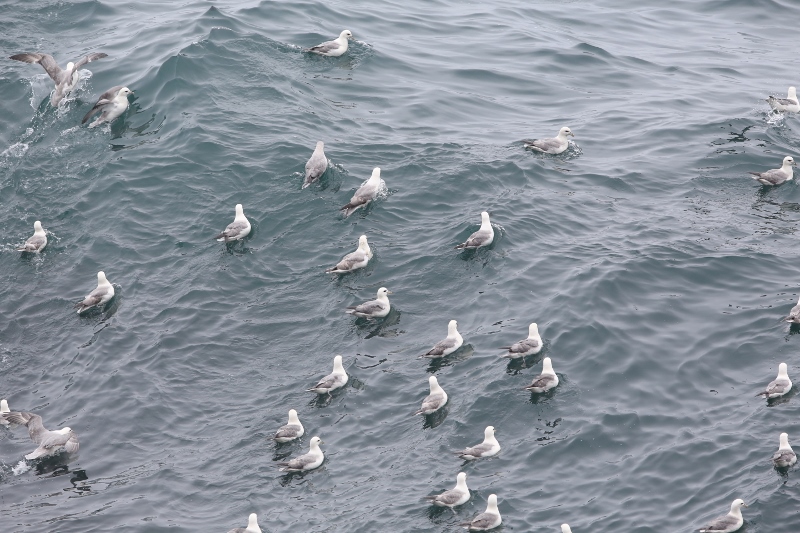Mapping of seabirds at sea
On the open sea, beyond the outermost skerries, we find the pelagic seabirds. Pelagic seabirds migrate over large sea areas, and live mainly on shoaling fish, zooplankton and fish fry. In cooperation with the Institute of Marine Research, SEAPOP collects data on the distribution of seabirds on the open sea. We map their distribution patterns and habitats, and we study their role in the marine ecosystem.
Pelagic seabirds
Seabirds live the whole or large parts of their lives on the open sea or in the coastal zone. Coastal seabirds, such as sea ducks, shorebirds, black guillemots and cormorants, live preferentially on benthos and fish in the coastal zone. Conversely, pelagic seabirds such as the little auk, Atlantic puffin, common guillemot, northern fulmar and black-legged kittiwake find their food in the free water masses, and it is these species that are found on the open sea. The majority of seagull species are opportunists, and can interchangeably use the coastal zone and the open sea.

Photo: Eirik Grønningsæter/WildNature.no
See our distribution maps for seabirds on the open sea, or conduct your own map and data search in the data portal!
Mapping at sea
Data is collected by counting seabirds from boats. We follow the Institute of Marine Research’s ecosystem research cruises, and count birds while the vessel sails along transects (straight lines) between sampling stations. Seabirds are one of many ecosystem components that are quantified on these expeditions. When seabird data is compiled with data on other components, we learn how the distribution of seabirds is connected to the marine environment and the occurrence of competitors and prey species. Read more about our methodology for mapping on the open sea.
We have data in our database from more than 660 000 kilometres of transects with counts of seabirds from all Norwegian sea areas and from all seasons. We use this data to construct distribution maps that are used in impact assessments and environmental risk assessments.
Read about and download our datasets from the seabird counts on the open sea.
Divers and surface feeders
The pelagic seabirds are often divided into pelagic diving seabirds and pelagic surface-feeding seabirds. Pelagic diving seabirds include species such as the Brünnich’s guillemot, Atlantic puffin and little auk. These species “fly” through the water. That is to say, they actively use their wings when they move under water. Those with the largest body size can dive down to over a hundred metres; they are skilled swimmers, and hunt fish and zooplankton in the open water masses. However, good diving skills have come at the cost of the ability to fly. Small wings and a relatively high body weight lead to high energy use when flying. Conversely, the pelagic surface-feeding species are skilled flyers. These species fly over large areas with little energy use. However, they are poor divers, and therefore must find their food in the uppermost section of the water column.
Hotspots and the distribution of seabirds
Frequent occurrences of seabirds are tied to areas with high biological production. This means that seabirds can be good indicators for particularly important marine areas where high biological activity is otherwise found, so-called “hotspots”. The relationship between productivity and seabird occurrence at sea has therefore been the focus of many studies over the past 40 years. Not surprisingly, the relationships are most apparent when observed on large scales. On a global scale, the highest concentrations of seabirds are found in sea areas with high primary production. In other words, in shelf areas, coastal areas, at relatively high degrees of latitude, as well as in the large up-welling areas on the west side of continents north and south of the equator. However, such relationships are far from obvious when observed on small scales. Often, different species are found distributed over different sea areas, rather than all species being concentrated in a few hotspots within one sea area. This distribution reflects niche segregation, where different species specialise in different food resources in different habitats. The majority of studies also show surprisingly weak relationships between concentrations of seabirds and prey species. The explanation for this is that the spatial relationship results from an interplay of seabirds searching for concentrations of prey species at the same time as the prey species try to escape from them. To complicate matters even more, seabirds use each other in their hunt for food. Diving seabirds can chase fish up to the surface, where they become accessible to surface-feeding species. At the same time, concentrations of seabirds will indicate that food is available, and thus attract birds from a larger area. The result of these mechanisms is that seabirds readily gather in large flocks. These flocks are often composed of several species; the flocks are relatively loose, and they are not always associated with high concentrations of food.

Photo: Eirik Grønningsæter/WildNature.no

